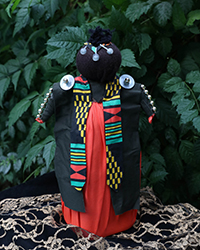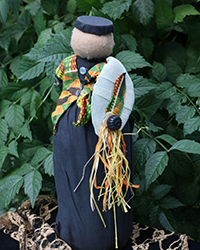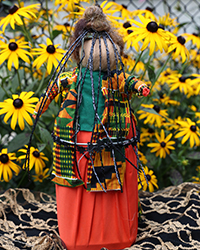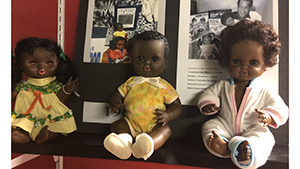Debra Britt and the National Black Doll Museum
Dolls are more than just a window into the joy and minds of children and people. – just ask the National Black Doll Museum’s Debra Britt. As the museum’s Executive Director, she highlights the need for representation in dolls, with more expansive storytelling and investigation to uncover the hidden truths and narratives of Black history.
In this interview, Britt’s life and pursuit of strengthening the public’s self-knowledge to cultivate discussions around topics including race and the cultural makeup of our society are explored.
Can you describe how the National Black Doll Museum came about?
I tell people this wasn’t what I chose, it chose me. I grew up poor in Boston…my parents were a part of the Black Panther movement.
(My grandmother)…would come home and take white dolls and dye them black because she wanted me to have good self-esteem.
People struggled but were trying to make a name for themselves despite white people telling us that we would never be better. My grandmother was a maid for The Kennedys. She would come home and take white dolls and dye them black because she wanted me to have good self-esteem. I wasn’t allowed to have white dolls. She created different images for me.
I started collecting because someone told me I wasn’t worth it.
How and why did this all begin? What was your career like before your current role?
I started collecting because someone told me I wasn’t worth it.
We moved to Dorchester, Massachusetts in 1962. I was the first Black student in an all Irish class. My first introduction to racism was in the first grade when a teacher humiliated me because I didn’t have sneakers. She told everyone a “poor black girl couldn’t buy shoes”. When I was in the third grade, a teacher told me “monkeys can’t learn”. That was my second introduction to racism in Boston.
 These experiences shaped who I was. I kept thinking ‘what is a bush boogie?’ That left a serious hole and I continued to ask ‘where do I come from? ’I spent my entire life looking, trying to figure this out. Black students went on strike and I ended up leaving high school in the 10th grade. I was educated through a program at a student strike center in Dorchester. In the fall I attended Northeastern University having earned enough credits to attend the university full-time. I later became an educator and daycare director. I would set up the first Black library at the of African American Institute at Northeastern University (they didn’t have a Black library).
These experiences shaped who I was. I kept thinking ‘what is a bush boogie?’ That left a serious hole and I continued to ask ‘where do I come from? ’I spent my entire life looking, trying to figure this out. Black students went on strike and I ended up leaving high school in the 10th grade. I was educated through a program at a student strike center in Dorchester. In the fall I attended Northeastern University having earned enough credits to attend the university full-time. I later became an educator and daycare director. I would set up the first Black library at the of African American Institute at Northeastern University (they didn’t have a Black library).
 I became Intrigued by dolls gifted by my grandmother, from Africa and felt I needed to protect kids from my experiences.
I became Intrigued by dolls gifted by my grandmother, from Africa and felt I needed to protect kids from my experiences.
Black Doll History
The National Black Doll Museum’s collection currently surpasses 7,000 dolls. What’s the lineage?
We have collections depicting every war and event in history and we create programs around history, often offering free programs for homeless and women’s shelters and covering the cost of lunch and supplies for children.
We’ve become caretakers of other people’s collections, especially after people pass on. I get letters detailing different stories and history—one woman wrote that she was smuggled from Nazi Germany and the first thing they gave her was a Black doll. We have a Barbie collection with well over 800 Black Barbies, this was a result of my sister having a stroke and developing a desire for barbies. We kept buying her dolls until she was able to walk again.
Can you share a highlight of the museum’s doll collection?
The Highlight of the museum’s collection for me was the Gallery of Self discovery. It included the “Ugly Truth”, Dark Treasures, and the Middle Passage. In it we would examine caricature dolls, golliwogs, mammies’ topsy-turvy dolls, paddle dolls, wishbone dolls, African Queens, Tribal dolls, and more. I wanted the museum to be a place to have difficult conversations on race and we did.
 There is also the African Wrap Doll Collection. There are 780 dolls in that collection. Each doll was made by either myself or one of my two sisters who work with me, Felicia and Tammy. When we began this work, each time we visited a classroom, library, school, shelter, museum, wherever, we’d make samples.
There is also the African Wrap Doll Collection. There are 780 dolls in that collection. Each doll was made by either myself or one of my two sisters who work with me, Felicia and Tammy. When we began this work, each time we visited a classroom, library, school, shelter, museum, wherever, we’d make samples.
We’d bring the samples home and finish them. Those dolls were later used to create our slave ship girth in the museum.
What do you believe the National Black Doll Museum is striving to teach us?
“Until the lioness tells her story, the hunter will always be the hero” — from an African proverb.
We can’t go forward if we don’t know our past. Self-esteem is the most important characteristic that we possess, we must nurture it in ourselves and our children so that they understand the potential of their greatness. They are more than the sum of their mother and fathers but carry the gene pools of kings’ and queens’ powerful ancestors.
 The museum teaches us that we all have a place and a purpose and that we can all make an impact.
The museum teaches us that we all have a place and a purpose and that we can all make an impact.
Do you believe your enthusiasm for representation in history/dolls influences genealogy?
I believe the dolls’ purpose is to carry the stories of the artist, collector and families – each piece finds the one griot in the family to hold the secrets, write the stories and carry on the legacies. When there is no one else in the lineage they find the museum.
Have you resumed doll making workshops?
The museum actually never stopped its doll workshops. During Covid, we learned to adjust and began teaching classes online through Zoom. We have had programs in South Carolina, Kansas, and Las Vegas using Zoom and are scheduling a few in Indiana and Minnesota. We have also resumed our in-person classes in New York, Connecticut, and Massachusetts. We also travel if organizations book us.
Does the museum have an upcoming mobile unit/traveling exhibit?
We started as a traveling museum initially, so all of our exhibits are mobile and available for rental across the country.
We started as the Doll E Daze Project exhibiting the dolls in venues that were more accessible to people of color (ie: libraries, schools, youth organizations, boys and girls clubs, shelters, etc.). We purchased a couple of steamer trunks and had a couple of display cases made and would set the dolls up for an exhibit for thirty days to do a presentation and workshop
For More Information
Consider donating to the museum to help them maintain their collection and support ongoing operations. Follow NBDMHC on Facebook or visit nbdmhc.org for more information. Visit here for more information on upcoming events.
Looking to learn more about Black dolls?
The Black Doll Collectors Group on Facebook
The Annual Black Doll Collectors Convention
 NaBeela Washington, an emerging Black writer, holds a Master’s in Creative Writing and English from Southern New Hampshire University and Bachelor’s in Visual Advertising from The University of Alabama at Birmingham. She has been published in Eater, The Cincinnati Review, and others. Learn more at nabeelawashington.com.
NaBeela Washington, an emerging Black writer, holds a Master’s in Creative Writing and English from Southern New Hampshire University and Bachelor’s in Visual Advertising from The University of Alabama at Birmingham. She has been published in Eater, The Cincinnati Review, and others. Learn more at nabeelawashington.com.
Ladies and gentlemen, I am happy to announce that it’s that time of year again! That’s right. It’s time…
Copyright © 2024 Retiring & Happy. All rights reserved.








